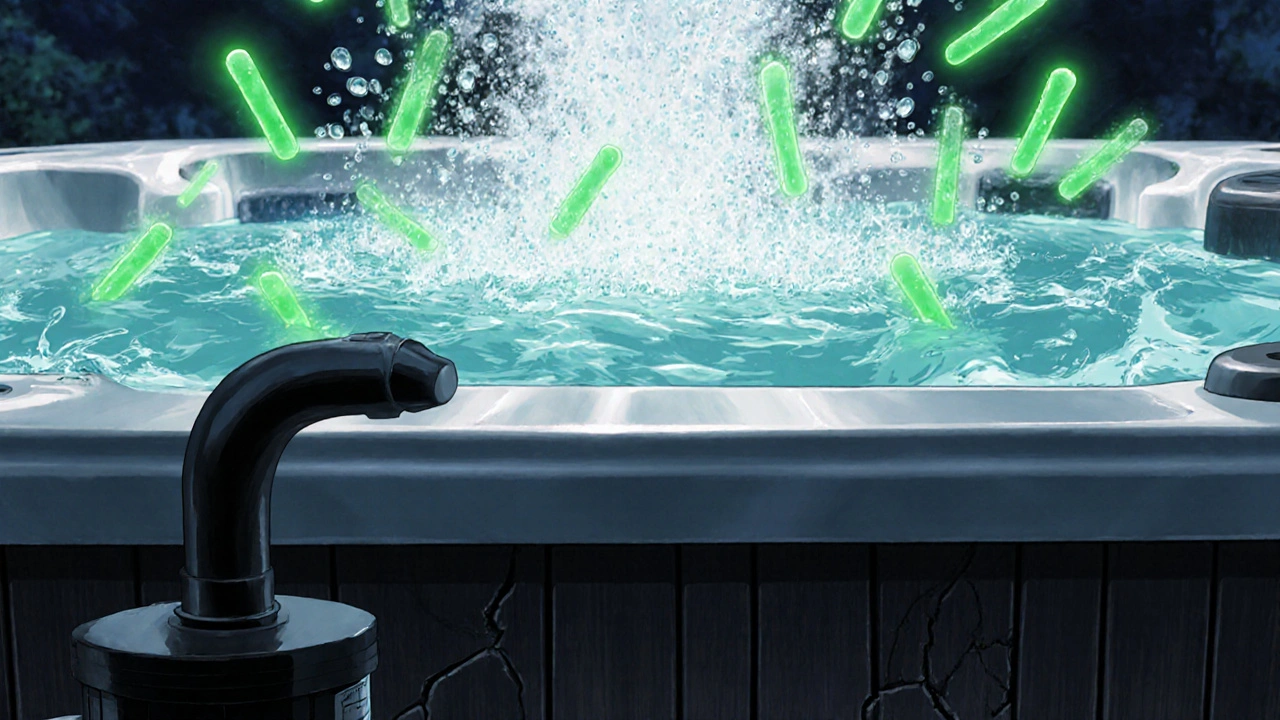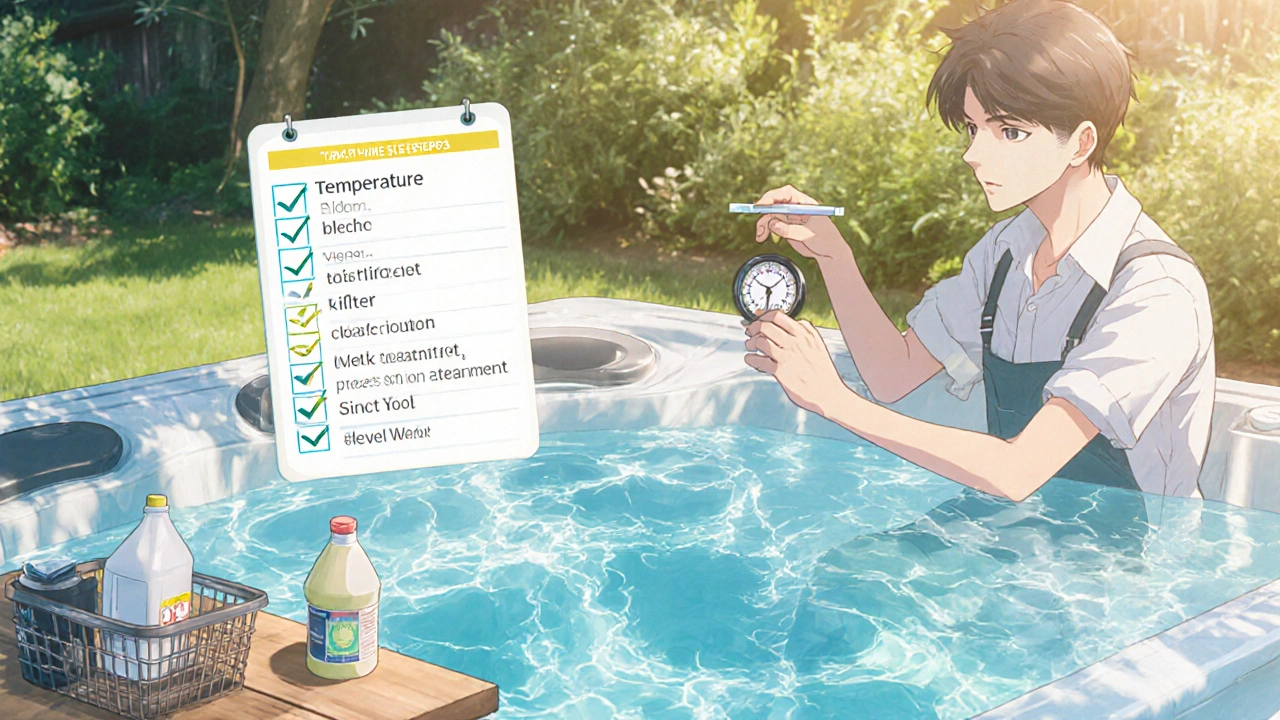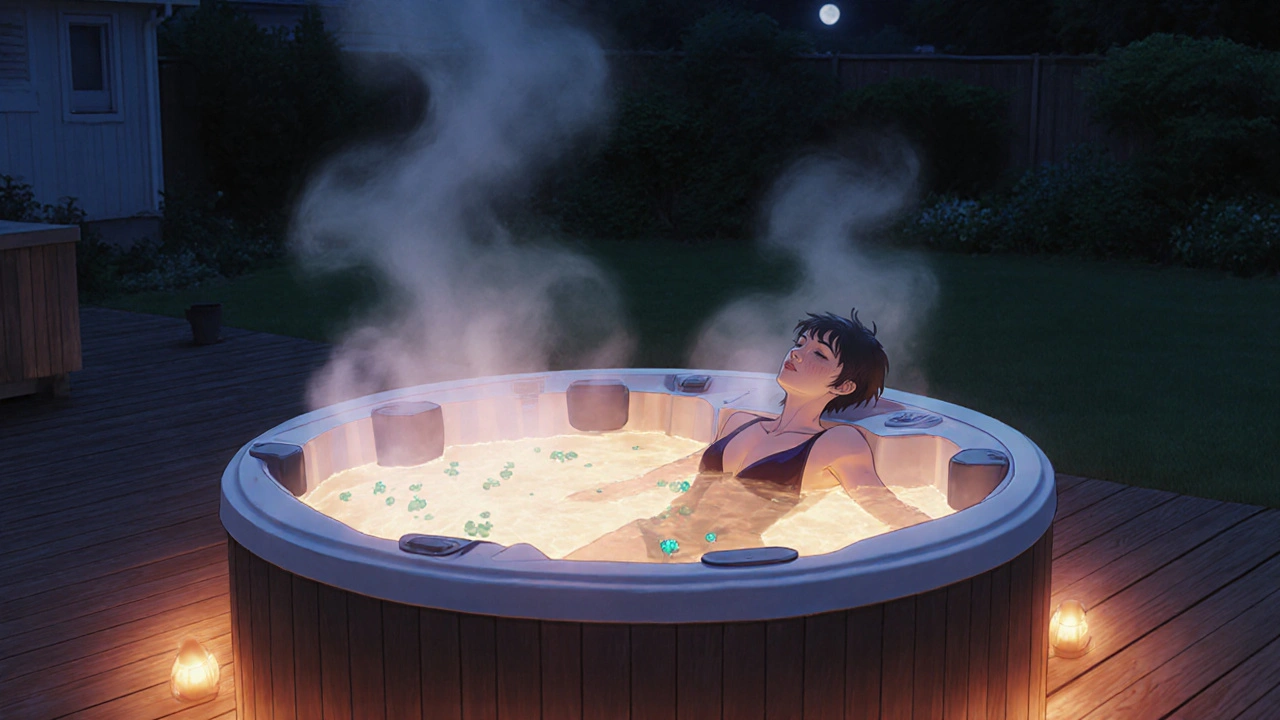Hot Tub Water Safety Checker
Ensure Your Hot Tub is Safe
Enter your hot tub's current parameters to check if it's within safe limits for preventing Legionella growth.
Results
Enter your hot tub parameters to see if it's safe
When you soak in a hot tub, you expect relaxation, not a trip to the hospital. Yet the warm, moist environment can become a breeding ground for a hidden threat: Legionnaires' disease. Understanding how this illness links to hot tubs helps you protect your family and keep your spa sparkling clean.
What is Legionnaires' disease?
Legionnaires' disease is a severe form of pneumonia caused by Legionella bacteria, often linked to contaminated water systems. First identified after a 1976 outbreak at an American Legion convention, the disease can cause fever, chills, cough, and muscle aches. In high‑risk groups-older adults, smokers, or people with weakened immune systems-the infection can be fatal.
Meet the culprit: Legionella pneumophila
Legionella pneumophila is the most common species responsible for human illness. It thrives between 20 °C and 50 °C (68 °F‑122 °F), multiplying rapidly when water sits stagnant for days. The bacteria are invisible to the naked eye and require a water source that can aerosolize-turn liquid into fine droplets you can inhale.
Why hot tubs are a perfect incubator
Hot tubs create the exact conditions Legionella loves:
- Consistently warm water, usually set between 100 °F and 104 °F.
- Low circulation if the pump or filter is off for long periods.
- Organic material such as skin cells, cosmetics, and biofilm that feed the bacteria.
When the water is agitated-by jets, bubbles, or a user’s movement-tiny Aerosol droplets are released into the air. Inhaling these droplets is the primary pathway for infection.

Other water sources that can spread Legionella
| Source | Typical Temperature Range | Maintenance Frequency | Risk Level |
|---|---|---|---|
| Hot tub | 100‑104 °F | Weekly water change, daily filter cleaning | High |
| Cooling tower | 68‑95 °F | Monthly biocide treatment | Very High |
| Decorative fountain | 70‑90 °F | Quarterly cleaning | Medium |
| Shower | Variable | Weekly pipe inspection | Low |
While hot tubs rank high on the risk scale, cooling towers-used in large buildings for air‑conditioning-have caused some of the biggest Legionella outbreaks in recent years.
Real‑world cases linking hot tubs to infection
In 2022, a community center in Ohio reported ten cases of Legionnaires' disease after a routine inspection uncovered inadequate chlorine levels in its public hot tubs. Another 2024 incident in a Florida hotel saw three guests diagnosed after the spa's filter had been offline for a week due to maintenance delays.
These examples show a clear pattern: lapses in water treatment and poor circulation directly translate into higher infection rates.
How to keep your hot tub safe
- Maintain proper temperature. Keep water between 100 °F and 104 °F; temperatures above 104 °F accelerate bacterial growth.
- Control chlorine or bromine levels. Aim for 3‑5 ppm free chlorine or 4‑6 ppm bromine. Test daily with a reliable test strip.
- Run the circulation system. Operate the pump for at least 8‑10 hours each day, even when not in use.
- Clean filters weekly. Remove, rinse, and soak filters in a diluted bleach solution (1 part bleach to 10 parts water).
- Shock the water regularly. Perform a shock treatment (chlorine or non‑chlorine oxidizer) every 1‑2 weeks, especially after heavy use.
- Use a certified Water treatment product. Look for EPA‑registered disinfectants designed for hot tubs.
- Schedule professional Legionella testing annually. Labs can detect bacterial counts and recommend corrective actions.
Following this checklist dramatically lowers the odds of Legionella taking hold.

What to do if you suspect infection
Symptoms typically appear 2‑10 days after exposure and include:
- High fever (often > 104 °F)
- Severe cough, sometimes producing sputum
- Shortness of breath
- Muscle aches and headaches
If you or a family member experience these after using a hot tub, seek medical attention immediately. Tell the clinician about recent hot‑tub exposure; they may order a urine antigen test, which provides fast results.
Key takeaways
- Legionella thrives in warm, stagnant water-exactly what a neglected hot tub offers.
- Proper disinfectant levels, regular circulation, and routine cleaning are non‑negotiable.
- Annual professional testing adds a safety net for high‑risk households.
- Early medical intervention saves lives; don’t ignore fever after spa use.
Frequently Asked Questions
Can chlorine prevent Legionella?
Yes, maintaining a free chlorine level of 3‑5 ppm continuously kills Legionella. However, chlorine alone isn’t enough if circulation is poor.
How often should I shock my hot tub?
Shock the water every 1‑2 weeks, or after heavy use, large parties, or when the smell of chlorine fades.
Is a hot tub filter sufficient to stop Legionella?
Filters remove debris but not bacteria. They must be paired with chemical disinfection and regular water turnover.
Can I use a UV sanitizer instead of chlorine?
UV units can reduce Legionella but are usually supplemental. EPA‑registered chemical disinfectants remain the primary safeguard.
What should I do if I see a foul smell from the hot tub?
A sour or chlorine‑burst smell often signals low disinfectant levels. Test the water, adjust chemicals, and run the pump longer before using again.






parth gajjar
October 19, 2025 AT 14:09Hot tubs are seductive death traps
Maridel Frey
October 20, 2025 AT 08:00For anyone maintaining a hot tub, it is essential to adhere to a strict schedule: test chlorine levels daily, run the circulation pump for at least eight hours, and replace the water completely on a monthly basis. Consistent documentation of these actions can prevent the buildup of Legionella and ensure a safe environment for all users.
Jay Kay
October 21, 2025 AT 02:03If you think a hot tub is just a fancy bathtub you are wrong. The bacteria love the warm, still water that many owners neglect. Keep the chemicals in check and the pump running, otherwise you are inviting trouble.
Rakhi Kasana
October 21, 2025 AT 20:06Legionella thrives in the exact conditions most people overlook: warm temperature, low flow, and organic debris. By ignoring proper circulation you essentially hand the bacteria a free pass to multiply.
Sarah Unrath
October 22, 2025 AT 14:10i cant even beleive some peopel neglect their spa its just crazy
James Dean
October 23, 2025 AT 08:13Seeing a hot tub left idle reminds me of a stagnant pond where microbes thrive unchecked.
Monika Bozkurt
October 24, 2025 AT 02:16In the domain of aquatic system safety, it is paramount to recognize that Legionella pneumophila exhibits optimal proliferation within the thermodynamic envelope of 20‑50 °C, a range routinely maintained by domestic hot tubs. The pathogen’s metabolic pathways are significantly accelerated at temperatures approaching the upper limit of this interval, thereby necessitating rigorous thermal regulation to mitigate microbial load. Contemporary disinfection protocols advocate for a free chlorine concentration of 3‑5 ppm, a parameter that, when sustained, imposes oxidative stress sufficient to disrupt bacterial cell membranes. Equally critical is the implementation of a continuous recirculation regime; empirical data suggest that a minimum of eight hours of pump operation per day reduces biofilm formation by upwards of 70 %. Filtration media should be serviced on a weekly cadence, employing a 1:10 sodium hypochlorite solution soak to decouple entrenched organic matrices. Moreover, periodic shock treatments-administered bi‑weekly or subsequent to high‑occupancy events-serve to re‑establish residual disinfectant potency after heavy organic loading. Integrating EPA‑registered biocidal agents alongside mechanical controls constitutes a layered defense strategy, aligning with the hierarchical risk mitigation framework endorsed by public health agencies. Routine Legionella surveillance, via culture‑based or molecular assays, provides quantitative feedback that can inform corrective actions before an outbreak manifests. In practice, this multidisciplinary approach-encompassing thermal management, chemical dosing, hydraulic optimization, and microbiological monitoring-constitutes the gold standard for hot‑tub safety. Stakeholders are encouraged to document each maintenance activity within a centralized log, thereby fostering accountability and enabling trend analysis over successive operational cycles. Ultimately, adherence to these evidence‑based protocols not only safeguards public health but also preserves the functional longevity of the spa infrastructure.
Penny Reeves
October 24, 2025 AT 20:20The checklist you provided is comprehensive, yet many owners find the shock treatment step especially cumbersome. If you automate dosing, you can cut down on manual errors. Also, remember that UV units are supplementary, not a replacement for chemical disinfectants.
Ankitpgujjar Poswal
October 25, 2025 AT 14:23Listen up, if you want a safe spa you must treat maintenance like a workout-no shortcuts, no excuses. Run the pump, test the chemicals, and shock the water regularly, or you’re just asking for trouble.
Bobby Marie
October 26, 2025 AT 07:26Neglecting filters? Bad idea.
Christian Georg
October 27, 2025 AT 01:30Great points, Penny 😊. Adding to your note on UV, I’ve seen labs report up to a 90% reduction in Legionella when UV is paired with proper chlorine dosing. It’s a solid backup, especially for high‑traffic facilities.
Christopher Burczyk
October 27, 2025 AT 19:33Contrary to popular belief, maintaining chlorine levels alone does not guarantee eradication of Legionella if water circulation is inadequate. Both chemical and hydraulic parameters must be optimized concurrently.
Nicole Boyle
October 28, 2025 AT 13:36From an engineering standpoint, the flow dynamics in a hot tub dictate biofilm detachment rates. Increasing the jet velocity by 15% can dramatically lower bacterial colonization.
Caroline Keller
October 29, 2025 AT 07:40I am sick of people treating hot tubs like luxury toys while ignoring the invisible killer lurking within! It’s high time we stop this dangerous complacency and take real action now.
dennis turcios
October 30, 2025 AT 01:43Your melodramatic warning does little without actionable steps. Focus on the facts: proper chlorine, consistent circulation, and regular testing are the only reliable defenses.